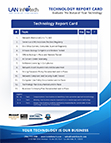Work-From-Home Cybersecurity: Are You Prepared For Long-Term Remote Work In 2021?
It’s a dangerous time right now, and not just because of COVID-19. Cybercriminals are taking advantage of the confusion and lack of awareness resulting from the global pandemic.
Do you know how to keep your employees, and your organization as a whole, secure?
The Benefits (And Risks) Of Remote Work
The remote work model offers a number of benefits that you’ve likely taken notice of over the course of the pandemic. Remote workers have seen the benefits as well:
- 77% of remote employees say they’re more productive when working from home
- 76% of employees prefer to avoid their office completely when they need to concentrate on a project
- 98% of remote workers want to continue to work remotely (at least some of the time) for the rest of their careers
However, for all the ways remote work is beneficial to both the organization and end-users, it’s not without its challenges. You’re reading this article, which means you’re worried about remote cybersecurity to some extent — and you should be. 36% of organizations have dealt with a security incident due to an unsecured remote worker.
According to Morphisec’s Work-from-Home Employee Cybersecurity Threat Index, 20% of workers said their IT team had not provided any tips as they shifted to working from home.
Is that the case for your remote workers?
Threats You Need To Be Aware Of In 2021
- Phishing Scams: Phishing emails still pose a major threat to the digital landscape of many business organizations across the globe. COVID-19 communications have provided the perfect cover for these emails to lure unsuspecting users. By creating a sense of urgency, these emails might persuade your employees to click on malware links that could steal sensitive data or install malicious viruses inside a computer.
- Ransomware: Targeted ransomware attacks are increasing every day. It is estimated that a ransomware attack will happen every 11 seconds in 2021. Ransomware attacks hold an organization’s critical data for a ransom, and millions of dollars are paid to hackers every year as corporations do not want to risk losing their sensitive data. However, there is no guarantee that your files will be secure even after you pay the ransom.
- Cloud Jacking: With the cloud becoming a more sophisticated way of storing data, incidents of cloud jacking have become serious threats. These attacks are mainly executed in two forms – injecting malicious code into third-party cloud libraries or injecting codes directly to the cloud platforms. As estimated by the 2020 Forcepoint Cybersecurity Predictions, a public cloud vendor is responsible for providing the infrastructure while most of the responsibility concerning data security rests with the users. So, bear in mind, you are mostly responsible for your data security even when it is on the cloud.
- Man-in-the-middle Attack: Hackers can insert themselves in a two-party transaction when it happens on a public network. Once they get access, they can filter and steal your data. If your remote working employees use public networks to carry out their official tasks, they are vulnerable to these attacks.
- Distributed Denial-of-Service Attack: This attack happens when hackers manipulate your normal web traffic and flood the system with resources and traffic that exhaust the bandwidth. As a result, users will not be able to perform their legitimate tasks. Once the network is clogged, the attacker will be able to send various botnets to the network and manipulate it.
Protecting Your Organization In 2021
- Two-Factor Authentication: Two-factor authentication is a great way to add an extra layer of protection to the existing system and account logins. By requiring a second piece of information like a randomly-generated numerical code sent by text message, you’re able to make sure that the person using the login credentials is actually who they say they are. However, this isn’t just for websites and common user accounts — 2FA should also be enabled for VPN and Remote Desktops.
- Conditional Access: Conditional Access software gives you the ability to enforce controls on the access to apps in your environment, all based on specific conditions and managed from a central location. It’s an extra layer of security that makes sure only the right people, under the right conditions, have access to business data.
- Data Loss Prevention (DLP): A DLP policy tracks sensitive data and where it’s stored, determines who has the authorization to access it, and prevents the accidental sharing of sensitive information.
- Email Security: Did you know that 96% of phishing attacks and 49% of malware attacks originate as emails? That’s why you should have powerful email spam and content filter protecting your organization’s inboxes. The right filter will defend against phishing, blatant malware threats, and that don’t involve malware, including impostor emails and business email compromise (BEC).
- Backups: Given that many businesses are using cloud-based platforms today, users often assume that their data is automatically backed up to a secure off-site location. But is that really the case? Reliable backup capability requires additional support. The key is in finding the right third-party backup solution to support your cloud-based accounts. By adding data backup capabilities, you can make sure all your bases are covered.
- VPN: When you use a virtual private network (VPN), your data is encrypted, or hidden, as it moves from your device to the VPN and then continues onto the Internet. That makes it harder for an attacker to identify you as the source of the data.
- Endpoint Protection: EDR is an emerging technology that addresses the need for continuous monitoring and response to advanced threats. This is a vital service that protects endpoints like laptops, desktops, smartphones, tablets, servers, and virtual environments. Endpoint protection may also include antivirus and antimalware, web filtering, and more.
Don’t Forget To Educate Your Staff
Did you know that more than 90% of cybersecurity incidents can be traced back to human error?
Cybersecurity awareness training is an essential part of an effective remote cybersecurity defense. Are your staff members supporting your cybersecurity? Or putting it at risk?
The fact is that what you (and your staff) don’t know could hurt you. If your staff isn’t up to date on the latest cybercrime scams, then they’re putting your data at risk, simple as that.
The key to truly comprehensive cybersecurity is simple, yet often overlooked: the user.
The best cybersecurity technology and practices in the world can be undone by one staff member who doesn’t understand how to use them, or how to protect the data they work with.
The right training services will offer exercises, interactive programs, and even simulated phishing attacks to test your staff on a number of key areas:
- How to identify and address suspicious emails, phishing attempts, social engineering tactics, and more.
- How to use business technology without exposing data and other assets to external threats by accident.
- How to respond when you suspect that an attack is occurring or has occurred.
Need Expert Guidance In Managing A Successful And Secure Remote Workforce?
If you need help securing up your remote work solutions, don’t assume you have to handle it on your own. Lan Infotech can assist — we will help you map out a cybersecurity strategy to protect your business during the remainder of the pandemic.
Over the course of the pandemic, we’ve gained extensive experience in helping our partners to launch, optimize, and secure remote work capabilities. Now that the mad rush to go remote is over, it’s time to perfect your processes. You don’t have to do so alone.
Get in touch with the Lan Infotech team to get started.

LAN Infotech is a Microsoft Cloud Services Provider, IT Managed Support company and a leader in helping law firms, nonprofits and medical organizations deploy cloud solutions, manage computer networks, keep data protected and top technology management company. Businesses like yours need technology support to run highly-effective organizations.



